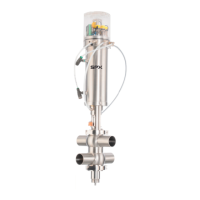Installation Waukesha Cherry-Burrell
Page 12 95-03087 10/2012
Fittings
When using suitable fittings, Mix Proof valves with detachable
connections can be installed in a pipe system per the fitting
requirements. The valve must be installed free of tension. After
the valve is installed in the pipe system, attach the control air
hoses and connect them to the electrical supply.
Contact WCB at 1-800-252-5200 for more information on our
wide variety of
fittings for all applications.
Pipeline Support
Install adequate supports to prevent strain on the fittings, valves
and equipment connections.
.
1. Install supports at least every 10 feet on straight runs of pip-
ing. (Figure 2, item C).
2. Install supports on both sides of the valves as close as possi-
ble to the connections. (Figure 2, item D).
3. Install supports at each change of pipeline direction. (Figure
2, item E and F).
4. For pipelines passing through walls, floors or ceilings, provide
at
least 1 inch (25 mm) of clearance around the pipe to allow
for expansion and contraction. (Figure 2, item G).
CAUTION:
In higher temperature applications, ensure
proper accommodation for thermal expansion in the
pipeline design to minimize stresses on the valve bodies.
Excessive mechanical and thermal stresses can distort and
damage the valve bodies.
Installing Valve Manifolds
Install automatic valve manifolds with a uniform pitch for proper
drainage. Elevate one corner of the cluster and pitch 1/16" per
foot (1.59 mm per meter) if desired. Arrange the supports for the
floor-mounted valve manifolds to provide alignment of the inlet
and outlet lines.
Installing the Valve
1. If solenoids are mounted in a control top, connect the air sup-
ply lines to “air in.” If solenoids are mounted externally from
the control top, connect the air lines as explained in “Solenoid
Valve Port Connections” on page 16.
2. Using caution, lift the actuator asse
mbly and set the actuator
in the body assembly.
3. Lower the valve slowly into the body, making sure the lower
st
em enters the lower bearing carrier.
4. Tightly clamp the yoke/body flange.
5. Connect the air lines to A, B and C, as shown in Figure 9 on
page 15
Figure 2 - Pipeline Support

